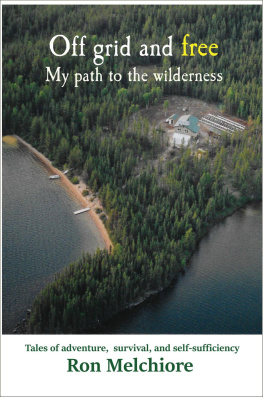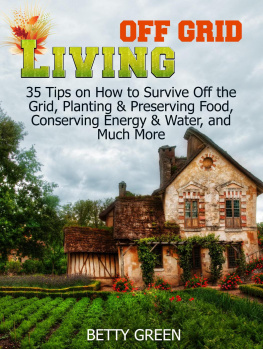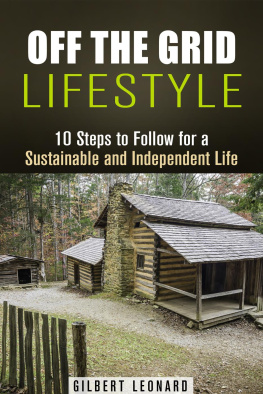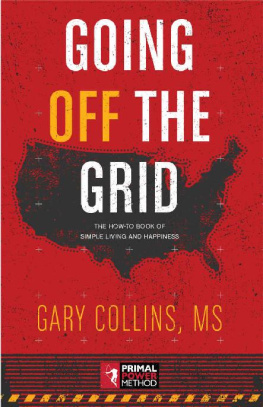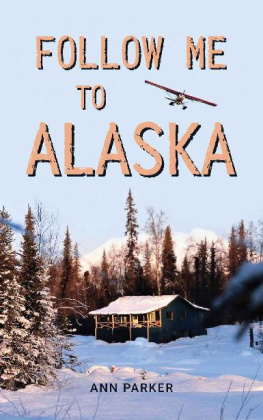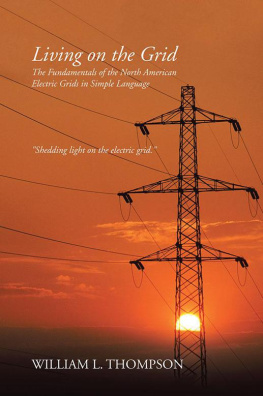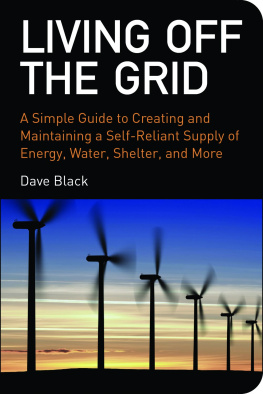Off Grid and Free
My Path to the Wilderness
Ron Melchiore
Copyright 2016 Ron Melchiore
ISBN 978-1-7781745-0-6
Second Edition
The cover photos, and photos within, are Ron Melchiore. Michelle Crean designed the front cover.
All rights reserved. No part of this book may be reproduced or transmitted in any form or by any means, electronic or mechanical, including photocopying, recording, or by any information storage and retrieval system without the written permission of the authors, except where permitted by law.
P ublisher: Ron Melchiore Nova Scotia, Canada
D EDICATED TO MY MOM , who supplied my daily fix of sweets, and my dad, who was always available to throw the baseball or football and wondered why I had such boundless energyI got to the chocolate chip cookies first, Dad.
And to off gridders, homesteaders, and other self-reliant people worldwide who dare to be different and free.
H UMANS ARE IDEALLY supposed to be visitors who do not remain in the wildernessat least if we go by the U.S. Wilderness Act and a variety of laws and regulations that have been enacted throughout the world to preserve wilderness. To preserve it, that is, by separating human nature from nature. The notion of the separation of people and wilderness, or society and nature, has lately been subject to a great deal of criticism because it ignores the traditional practices and land claims of both indigenous populations and settlers who have made wilderness their place of dwelling and because it has historically resulted in countless evictions and displacements of wilderness residents following the legal designation of a tract of land as park or reserve. So can any human being, nowadays, up and move into the wilderness? How can one manage to live full-time in the wilderness? And is a wilderness area still wild after a human has chosen to remain there?
I spent two years between 2011 and 2013 traveling across all of Canadas provinces and territories to find people who live off the grid (i.e. in homes disconnected from electricity and natural gas networks) and document their way of life. Many of the off gridders I found lived in exurban, rural, and peripheral areas. But in February of 2013 I met a couple who lived full-time far more remotely than anyone else and who indeed lived further away from human civilization than anyone I had ever heard of. Ron and Johanna lived in Northern Saskatchewan, 100kms away from the nearest road of any kind and 160kms away from the nearest town. They had lived there for about a decade.
Ron and Johannas home could only be accessed by small planes equipped for landing on water or ice. Soon after I got off that floatplane in the middle of February I learned that they typically chartered it only twice a year to stock up on the few supplies they could not otherwise grow or build on their own. Their home was entirely self-sufficient for electricity and heat, thanks to a hybrid system that made use of solar and wind (with a small back-up diesel generator) to generate power, and locally harvested firewood for heating and cooking. Water was sourced from a well. Waste and sewage were sustainably disposed of locally. And, while they bought a good deal of meat and other provisions during their twice-yearly trips, they managed to grow much of their calorie intake right there in their garden and greenhouse. Old-fashion home-making and building skills allowed them to build, repair, and craft a good deal of the things and technologies they needed on a daily basis. Despite all this, Ron and Johanna were no hermits: they kept connected to the rest of the world via a satellite link that permitted them to watch television, access the internet, and make (emergency) phone calls.
What brought Ron and Johanna from their previous home in New England so far away from the rest of society? And how did they manage to not only survive but indeed thrive in a place so remote? In the wonderful tales this book contains, the answer will ring clear and true, and you will have to read to find out.
While their remoteness was unusually dramatic, their values are common to many people who call the bush home across much of Canada, the United States, and Australia. Getting away from it all is indeed an increasingly sought-after form of lifestyle migration drivenunlike much migratory patternsnot by economic reasons but rather by the existential need to live life on ones own terms, in a more basic and simple (though obviously at times very complicated!) manner. In this way, wilderness areas serve as prime testing grounds for such lifestyle experiments, allowing individuals to start fresh, to clean the slateas it wereand re-invent modern living.
Did Ron and Johanna undo wilderness in virtue of choosing to remain there? In other words, did theyin light of choosing to stay, rather than simply visit and leaveturn their wilderness into a less pristine, less wild environment? One could very well argue that their cozy homewith its stocked pantry and warm roomswasnt wild. As a permanent structure meant to give them comfort and convenience, their off-grid home wasnt much different from your home or ours. But just a few steps away from their wind turbine, the bush was as wild as it would have been before, or without, their arrival. As Ron and I would walk the trail surrounding their landas we did daily for the time I was their guestwe would quickly and punctually lose sight and sound of anything that wasnt wild. Meeting them taught me that choosing to remain in a wilderness area, and practicing a low-impact lifestyle, does not spoil the experience of the wild. People belong in the wilderness. And they can do so without becoming wild themselves, but rather simply by accepting the value of wildness and welcoming some of that wildnessinstead of simply confining it to a distant park or reserveinto their home.
-Phillip Vannini, Professor, Royal Roads University, July 10, 2015
Next page
